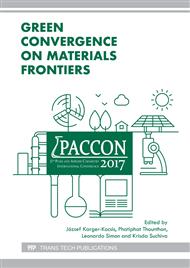p.120
p.125
p.131
p.141
p.146
p.151
p.156
p.161
p.166
Enhancement of Hydrogen Production from Sugarcane Bagasse by Klebsiella pneumoniae subsp. pneumonia DSM 30104(T) Using Statistical Methods
Abstract:
This study employed statistically based experimental designs to optimize environmental factors for H2 production from sugarcane bagasse hydrolysate by K. pneumoniae subsp. Pneumonia DSM 30104(T) isolated from wastewater sludge using statistical method. The 12 runs of Plackett-Burman design were used to classify important factors influencing the H2 production from sugarcane bagasse hydrolysate by K. pneumonia subsp. pneumonia DSM 30104(T). Mutual interaction between the significant factor and their optimal values that brought the maximum H2 production (mL H2/L) were further investigated using Box-Behnken design of response surface method. Experimental results indicated that yeast extract, ammonium chloride, potassium chloride, calcium chloride, iron (II) sulfate and total sugar of sugarcane bagasse had an interdependent effect on the maximum H2 production while only interaction effect between yeast extract and calcium chloride had statistically significant (P≤0.05) influences on the maximum H2 production. Optimal conditions for the predicted maximal H2 production were 7.50 g/L yeast extract, 0.50 g/L ammonium chloride, 15.0 g/L potassium chloride, 0.75 g/L calcium chloride, and 10.0 g/L total sugar. At the optimal condition, the maximum H2 production of 277 mL H2/L was estimated from Box-Behnken design that more than 9 times compared to Plackett-Burman design. The highest ratio of butyric acid to acetic acid (B/A ratio) of 1.47 was indicated the high performance of H2 fermentation of sugarcane bagasse hydrolysate by K. pneumoniae subsp. Pneumonia DSM 30104(T) under the optimal condition obtained.
Info:
Periodical:
Pages:
146-150
Citation:
Online since:
October 2017
Authors:
Price:
Сopyright:
© 2017 Trans Tech Publications Ltd. All Rights Reserved
Share:
Citation:


